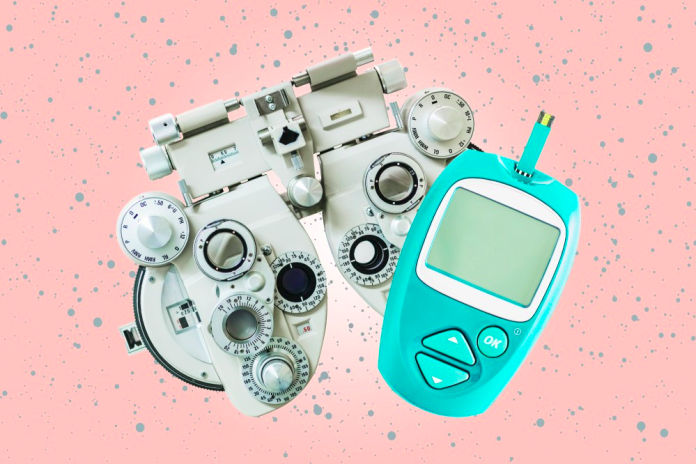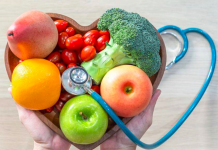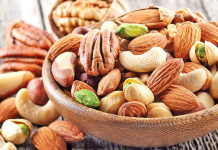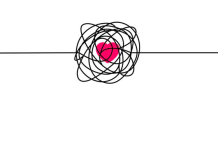According to the Centers for Disease Control and Prevention, 34.2 million Americans have diabetes and another 88 million have prediabetes. All told, that’s more than 1 in 3 people in the U.S. who have either been diagnosed with diabetes or are dangerously close to it.
Diabetes is a big public health concern, but most people don’t realize that it impacts more than just our metabolic health. When someone has diabetes, they lose the ability to regulate blood sugar (aka glucose), either because their body can’t produce insulin (this is called type 1 diabetes) or because they’ve become resistant to insulin from chronically high blood sugar levels (this is called type 2 diabetes).
In either case, people with diabetes run the risk of having consistently high blood sugar levels, which can cause damage all over the body, including in the eyes.
How Does Diabetes Affect The Eyes?
Here are a few common eye conditions that are associated with diabetes.
Diabetic Retinopathy
A major potential complication of diabetes is diabetic retinopathy. This is vision loss or blurriness due to chronically elevated blood sugar, which eventually damages the retina. Over time, excess glucose can block the tiny blood vessels in the eye, which leads to fluid leakage or bleeding. If left unmanaged, it can even lead to retinal detachment and blindness in severe cases. Your eye doctor can check for diabetic retinopathy at your annual eye exam.
Cataracts
People with diabetes are two to five times more likely to develop cataracts. Cataracts are cloudy areas in the eye lens which lead to blurry or less colorful vision. Chronically high blood sugar levels can disrupt lens metabolism, ultimately leading to cataract formation. Unfortunately, the only treatment for cataracts is surgery, which is why it’s critical to prevent their formation whenever possible. This is something your eye doctor can also check for at your annual eye exam.
Glaucoma
Diabetes doubles your risk for glaucoma, a group of eye diseases caused by damage to the optic nerve. If left unnoticed or untreated, glaucoma may result in vision loss or blindness. There is no cure for glaucoma, but early identification and treatment can help stop the condition from progressing. It still isn’t clear how diabetes is linked to glaucoma, but it may be due to high blood sugar ultimately increasing intraocular pressure (fluid pressure inside the eye) and damaging the optic nerve. Check with your eye doctor about your glaucoma risk at your annual eye exam.
Ways to Prevent Damage to Your Eyes with Diabetes
Chronically high blood sugar levels are the biggest concern when it comes to eye health and diabetes. The best way to prevent eye damage is to keep your blood sugar levels in a healthy range consistently through a combination of diet, lifestyle and medication as needed. Here are some of simple and effective tips for keeping your blood sugar and eye health in check.
Balance Your Blood Sugar with the Plate Method
What does a well-balanced diet look like if you have diabetes? An easy way to think about it is using the Diabetes Plate Method. Make one-quarter of your plate a lean protein—such as chicken, fish, tofu, eggs or edamame. Fill another quarter of your plate with a complex carbohydrate.
This can be fruit, beans, a whole grain like brown rice, quinoa or oats, or a starchy vegetable like potatoes, corn, peas or winter squash. The remaining half of your plate should be filled with nonstarchy vegetables like spinach, asparagus, broccoli, cauliflower, carrots, cabbage, okra, mushrooms, tomatoes, onions or leafy greens.
Using the Plate Method gives you an easy visual cue to make sure you get enough protein, an appropriate amount of carbohydrates and a lot of nutrient-dense vegetables to help keep you full and feeling your best. It’s also important to eat regularly throughout the day and to spread out your carbohydrates evenly across meals to avoid spiking your blood sugar.
Key Nutrients for Eye Health
Beyond keeping your blood sugar levels balanced, researchers have uncovered several nutrients that are important for eye health and reducing the risk for eye disease. If you have diabetes, be sure to add in these key nutrients to protect the health of your eyes.
Beta carotene
A precursor to vitamin A, beta carotene is a powerful antioxidant that can help reduce oxidative stress within the eye. Left unchecked, oxidative stress can damage the retina and worsen vision. Beta carotene usually shows up in foods as an orange pigment, so you can find it in carrots, sweet potatoes, winter squash, cantaloupe and apricots.
Lutein and Zeaxanthin
Similarly to beta carotene, lutein and zeaxanthin are orange pigments that act as powerful antioxidants in the eye, reducing oxidative stress. Diets rich in lutein and zeaxanthin have been associated with lower risk of glaucoma and age-related macular degeneration. Great sources of both antioxidants include egg yolks, leafy greens, corn and einkorn.
Vitamin C
Some scientific evidence suggests that vitamin C plays a role in reducing oxidative stress in the eye as well, though this is still an open area of research. Another powerful antioxidant, vitamin C can be found in tomatoes, citrus fruits, potatoes, broccoli, strawberries, cantaloupe and Brussels sprouts.
Vitamin E
You may be noticing a trend here: vitamin E is another powerful antioxidant. It can help reduce oxidative stress in the eye by quenching free radicals that can otherwise cause damage to the retina and other important parts of the eye like photoreceptors. Good food sources of vitamin E include vegetable oils, peanut butter and many nuts and seeds.
Omega-3 Fatty Acids
Similar to the antioxidant nutrients we’ve mentioned, omega-3s help fight inflammation and oxidative stress. Omega-3s are unique in that they may be the key mediators in bringing specific inflammatory processes to a close. Unfortunately, the standard American diet is very low in omega-3 fats, but there are several delicious ways to include more in your diet. Good sources include fish (especially salmon, tuna and mackerel), chia seeds, flaxseed and walnuts.
Zinc
Zinc plays a few roles in preserving or improving eye health. It decreases inflammation and oxidative stress, and plays a major role in getting vitamin A to the eye. Zinc deficiency has even been linked to poor night vision. Oysters, chicken, red meat, beans, nuts, fortified breakfast cereals, dairy products and whole grains are all great sources of zinc.
Bottom Line
Diabetes is associated with several different eye conditions, including diabetic retinopathy, cataracts and glaucoma. This is primarily due to consistent high blood sugar levels over time. The good news is that you can decrease the risk of diabetes-related eye disease by keeping your blood sugar balanced and adding in key antioxidants, vitamins and minerals to your diet. For more, check out the best foods for eye health, according to a dietitian.















